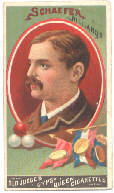Cushion caroms

Jacob Schaefer, Sr. tobacco card, circa 1880s
|
|
| Presence | |
|---|---|
| Olympic | No |
| Paralympic | No |
Cushion caroms (or cushion carom billiards) sometimes called by its original name, the indirect game, is a carom billiards discipline generally played on a cloth-covered, 5 foot × 10 foot, pocketless table with two cue balls and a third red-colored ball. The game is sometimes incorrectly referred to as one-cushion or one-cushion billiards, which is the direct translation of its name into English from various other languages such as Spanish ("una banda") and German ("Einband").
Cushion caroms is traceable to 1820s Britain and is a descendant of the doublet game dating to at least 1807, which required the sole object ball to be banked off a cushion before being pocketed or, as it was described in 1833: "...no hazard is scored unless it is made by reverberation."
The name of the game is taken from the pre-existing shot. In a cushion carom shot, the cue ball caroms (strikes and rebounds) off of both object balls with at least one rail being struck before the hit on the second object ball. The object of the game is to score up to an agreed upon number of cushion caroms, with one point being awarded for each successfully made. If no object ball is contacted, one point is deducted. If there is ambiguity as to whether the second ball was contacted, it is resolved in favor of the shooter.
Cushions caroms was defunct for a number of years, but was revived in the late 1860s as an alternative to the game straight rail, in which points are scored by a simple carom off both object balls with no cushion requirement. Straight rail had for a time been falling into disfavor based on frustration by spectators with skill developments which allowed top players to monotonously score a seemingly endless series of points with the balls barely moving in a confined area of the table playing area. This was a result of the "rail nurse", a shot in which the object balls are nudged at very soft speed down a rail to a duplicate position again and again.
...
Wikipedia
